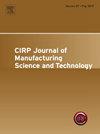Mechanism, calculation method, and analytical modeling of spindle thermal characteristics considering radiation heat transfer
IF 5.4
2区 工程技术
Q2 ENGINEERING, MANUFACTURING
CIRP Journal of Manufacturing Science and Technology
Pub Date : 2025-06-19
DOI:10.1016/j.cirpj.2025.06.012
引用次数: 0
Abstract
Neglecting the effect of thermal dissipation by radiation heat transfer (RHT) in spindle system may lead to calculation errors in the finite element model and analytical model of temperature field and thermal errors. As a result, the actual temperature field and thermal error of the spindle cannot be truly characterized and the effectiveness of the compensation of the spindle based on the analytical model will be diminished. To address this issue, this article studies the heat dissipation mechanism of RHT of spindle system and proposes a Monte Carlo-Radiation Network Method (MC-RNM) for real-time calculation of net RHT in the spindle system during the operation of the machine tool. Then, the study proposes an improved thermal network method (I-TNM) to establish an analytical model for spindle temperature field and thermal error, taking into account RHT. It was also shown that the analytical model of the spindle taking into account RHT yields better accuracy and generalization in the calculations of temperature field and thermal error. Under different operating spindle conditions, the maximum error between the calculated steady-state temperatures at the left end face and lateral surface of the spindle and the experimental values is less than 0.4ºC. Additionally, the maximum error between the calculated steady-state thermal errors and experimental values is within 2 µm. The findings enhance the theoretical research on boundary conditions in precision spindle systems, providing theoretical support and guidance to advance the research investigating thermal structure design of the spindle and thermal error compensation.
考虑辐射传热的主轴热特性的机理、计算方法及分析建模
忽略辐射传热对主轴系统散热的影响会导致有限元模型和温度场解析模型的计算误差和热误差。这样就不能真实表征主轴的实际温度场和热误差,降低了基于解析模型对主轴进行补偿的有效性。针对这一问题,本文研究了主轴系统RHT的散热机理,提出了一种蒙特卡罗辐射网络法(MC-RNM),用于机床运行过程中主轴系统净RHT的实时计算。然后,提出了一种改进的热网络法(I-TNM),建立了考虑RHT的主轴温度场和热误差的分析模型。结果表明,考虑RHT的主轴解析模型在计算温度场和热误差时具有较高的精度和通用性。在不同的主轴工况下,主轴左端面和侧面稳态温度计算值与实验值的最大误差小于0.4ºC。稳态热误差计算值与实验值的最大误差在2µm以内。研究结果加强了精密主轴系统边界条件的理论研究,为主轴热结构设计和热误差补偿的研究提供了理论支持和指导。
本文章由计算机程序翻译,如有差异,请以英文原文为准。
求助全文
约1分钟内获得全文
求助全文
来源期刊

CIRP Journal of Manufacturing Science and Technology
Engineering-Industrial and Manufacturing Engineering
CiteScore
9.10
自引率
6.20%
发文量
166
审稿时长
63 days
期刊介绍:
The CIRP Journal of Manufacturing Science and Technology (CIRP-JMST) publishes fundamental papers on manufacturing processes, production equipment and automation, product design, manufacturing systems and production organisations up to the level of the production networks, including all the related technical, human and economic factors. Preference is given to contributions describing research results whose feasibility has been demonstrated either in a laboratory or in the industrial praxis. Case studies and review papers on specific issues in manufacturing science and technology are equally encouraged.
 求助内容:
求助内容: 应助结果提醒方式:
应助结果提醒方式:


